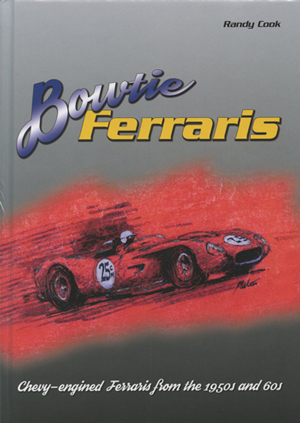 Bowtie Ferraris:
Bowtie Ferraris:
Chevy-engined Ferraris from the 1950s and 60s
By Randy Cook
RAC Motosports Publishing 2015 Hardback
ISBN 978-0-692-30836-3
192 pages, 270 color and b&W images
$45.95 plus shipping Out of stock!
Review by Michael T. Lynch
The Untold Story of the Illegitimate Children of Ferrari and Chevrolet
In these days of eight figure auctions prices, Ferraris are held in the highest esteem in collector circles. Some acolytes act is if these cars were gifts from heaven, rather than coming from an industrial area in Italy with a bad climate and smog caused by tile factories. I forgive all that because of Reggiano Parmigiano.
The worshipers might feel differently if they knew it was not always so. Some of the great Ferraris in the history of the marque were relegated to barns, chicken coops and abandoned to the elements for years before being restored to the specification they now present at the great concours and vintage races of the world. Any kind of variance from “original” is considered a sacrilege. The idea of a non-Ferrari part on a significant car almost makes some faint. However, race cars were changed, sometimes from race to race to be made more competitive, so who is to say what is original.
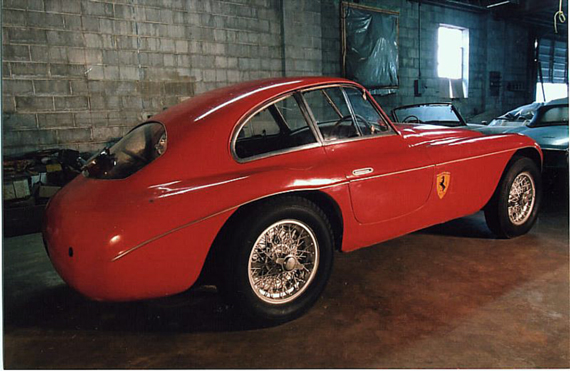
S/N 0046 was a Touring bodied barchetta modified by Zagato and later equipped with a Chevy V8. Photo credit Darrell Westfaul, from the book.
The fact of the matter is that when early Ferraris arrived in America they were successful for a time in racing. Nothing is older than last year’s race car, so they changed owners and dropped down the results sheets as years passed. The next part of the cycle began when the Ferrari engines gave up. Now, the owner was in real trouble, because the cost of an engine rebuild was much more than the car was worth. Even at that late date, the Ferrari chassis was still often superior to some of its competition. Developments in the U.S. auto industry would affect what happened next.
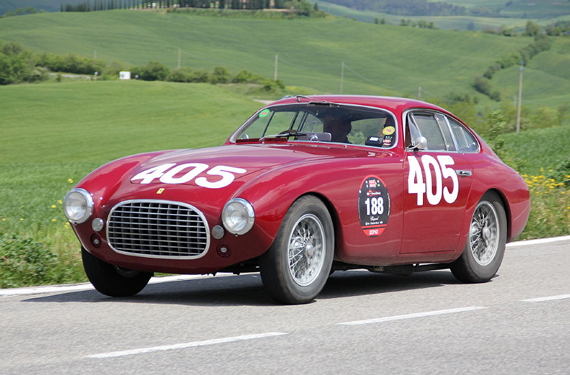
Most of the superb color images for the Bowtie Ferrari book are courtesy of Hugues Vanhoolandt, such as this view of 1951 Mille Miglia winner S/N 0082 on a recent Mille Miglia.
Ed Cole became Chief Engineer at Chevrolet in 1952. He had worked on Cadillac’s overhead valve V-8, introduced in 1949, an engine that found success in early sports car racing, mostly in Allards. At Chevrolet he designed a light, compact, short-stroke, overhead valve V-8, introduced in 1955, that almost immediately became the darling of hot rodders. It replaced their beloved Ford flatheads which had to have expensive speed equipment to equal the Chevy’s power and the newer V-8 also weighed 70 pounds less.
As the speed equipment industry added parts for the Chevrolet, its reliability in racing increased and they were often used in American road racing specials. Descendants of the small block Chevy V-8 remain in production today and it could be said that the engine has won more races across more disciplines that any engine in history. Cole’s later elevation to Head of the Chevrolet Division and ultimately, President of General Motors was not undeserved.
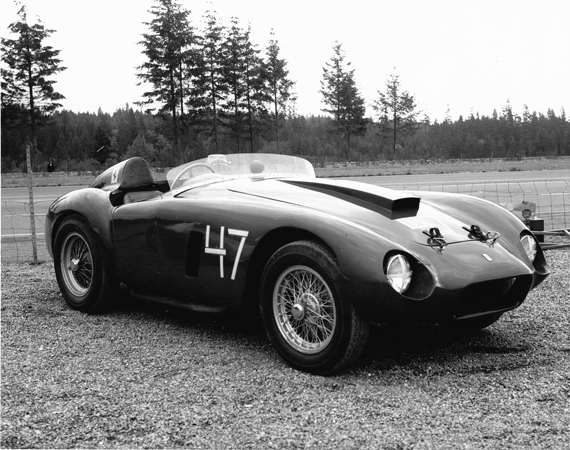
There are many period photos of the Chevy engined Ferraris. Here is S/N 0406 with a 310 inch Chevy V-8 as campaigned by Hal Rudow in 1962. Courtesy Martin Rudow, from the book.
Obviously, because of cost, reliability and availability, the Chevrolet V-8 began making its way into both racing and street Ferraris not long after its introduction. Some of the race cars continued to win despite their age.
Randy Cook has written a fascinating, well-researched book on this phenomenon – Bowtie Ferraris, Chevy-engined Ferraris from the 1950s and 60s. He takes us car-by-car in serial number order through 71 Chevrolet transplants into Ferrari cars produced from the beginning of the firm until the end of 1960.
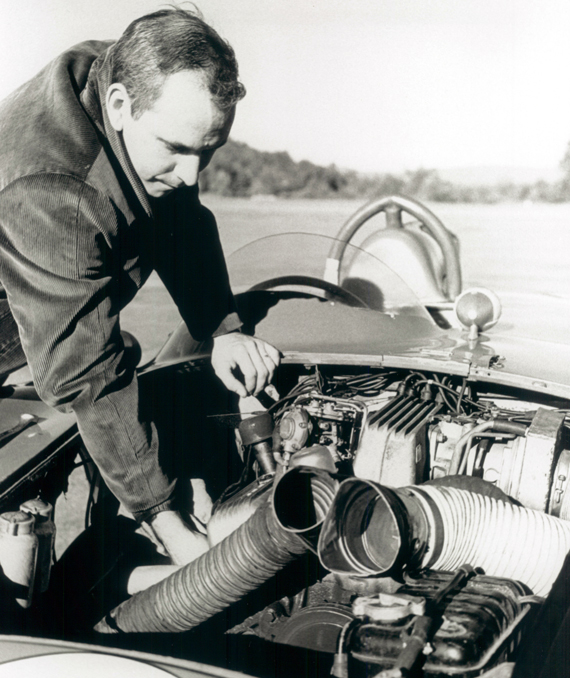
But photos of Chevy engines as installed in the Ferraris are harder to find. Here is Oscar Kovaleski working on the fuel injected Chevy engine installed in his famous 'Car 54 Where are You', S/N 0588. Photo from the book.
There is little doubt that the formation of the Ferrari Club of America in 1962 and the writing of the classic Warren Fitzgerald/Richard Merritt book, Ferrari The Sports and Gran Turismo Cars were inspired by what the purist Ferrari community viewed as desecration of important automotive artifacts. Some of the founders had seen a 166 Vignale Coupe 0024 (originally a Barchetta, then a coupe and now carrying a reproduction Barchetta body) at Elkhart Lake that year and it had been fitted with a Chevy. They were not impressed. Soon, another step in the process on the road from barns to the lawn at Pebble Beach began.
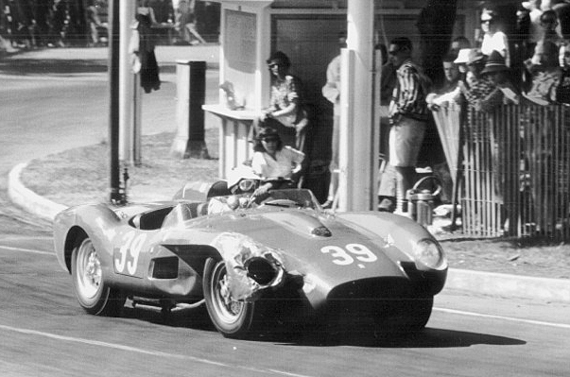
Even Testa Rossas received Chevy engines. Here is Gordon Glyer at Sacramento in 1961 with S/N 0718. When he sold it without the engine to Jack Wilke, a Chev was put in its place. Courtesy Web Canepa from the book.
Fitzgerald and Merritt taught us the basics of Ferrari’s numbering system and by the early 1970s, matching engine and chassis numbers had become the Holy Grail. Knowledgeable enthusiasts began to realize that to attain their highest value as collectibles; Ferraris would have to be reunited with their original engines. This set off a search by a knowledgeable few. Some had the money to buy engineless cars and look for the engines later. More impecunious cognoscenti concentrated on finding the engines, hoping for higher bids later from the car owners. I wrote about the latter part of the odyssey in a slightly fictionalized piece in Cavallino 23 (Aug/Sept 1988). It has certainly paid off for some. A recent transaction traded a four cylinder Ferrari engine intended for its original chassis in exchange for a complete restoration of a mid-50s Ferrari race car.
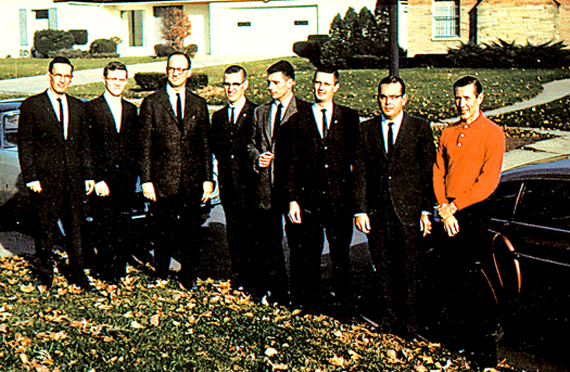
The founding of the Ferrari Club of America, November 19, 1962. From left, John Delamater, Ralph Smith, Gerry Buhrman, Dick Merritt, John Lundin, Ken Hutchison, John Habach, Larry Nicklin.
Randy’s book makes for both a wonderful read and an important reference. When the information is all in one place it becomes immediately apparent how many highly significant Ferraris did get a Chevrolet transplant. They include two Mille Miglia winners (1951 and 1953), the first place Ferrari from the 1954 Carrera Panamericana and Jim Kimberly’s cut-fendered Ferrari 375 MM that totally dominated the 1954 SCCA racing season. Iconic models such as the 166 MM, 750 Monza, 500 TRC and 250 Testa Rossa all received Chevrolet engines.
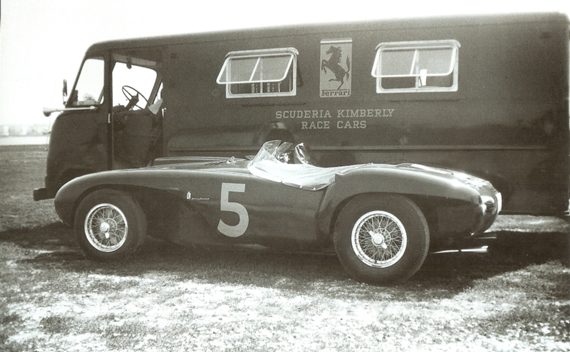
Jim Kimberly’s car at Fairfax Airport, Kansas City KS, in 1954 when it dominated SCCA C Modified. The car was painted the same red as the factory paint job on the truck. Credit Michael T. Lynch
One cannot write a review without some petty criticism. The only thing I can find fault with is the several names that are misspelled (Wayne Thomas was actually Wayne Thoms, etc.) and the incorrect designations of a few people’s positions in their descriptions (Warren Olson was not the chief mechanic in Lance Reventlow’s Scarab operation, but the General Manager). At least two captions are mislabeled. One identifies Richard Lyeth’s mechanic as Lyeth himself. In the section on 250 TR 0728, the 1958 Le Mans winner, there is a picture from a period Fuller Brush Catalog taken in front of the factory. It shows a Ferrari sports racer being looked at by Phil Hill and Gaetano Florini, later to become head of the Assistenza Clienti in Modena. The caption identifies it as 0728, but it is actually 0726 before it was converted to a 1959-style body. It is painted with Hill’s winning number from Le Mans earlier that year for this posed shot.
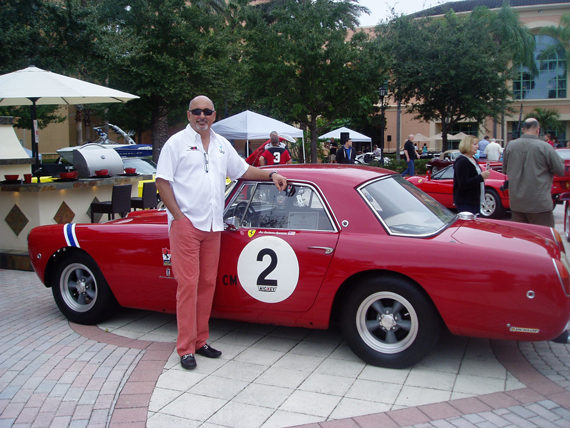
An approving Bobby Rahal stands next to Randy Cook's 250GT S/N 1175. The car and author will be appearing at selected events this season.
Indexes are fading from the publishing world, but considering some will be using the book as a reference, one would have been preferable. Jody Ellis did a fine job of layout and there is a bibliography. I was not impressed with the front cover artwork, but the back cover shows three cars from the book, including Randy Cook’s. They tell us what the book is about.
Historians often know more about a car than the owner, but Cook’s book, shows that Packard’s 1901 slogan, “Ask the Man Who Owns One” is often the best source of information. Randy has owned a Chevrolet-powered Ferrari Pinin Farina Coupe for many years. He has now written a book on his car’s brethren that does a great service for the Ferrari community and beyond.
The question remains; are there enough non-Chevrolet transplants into Ferraris to make another book?
Author Randy Cook will be at Amelia, March 13-15, 2015 to sign and sell his new book.
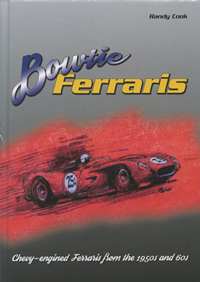 Bowtie Ferraris: Chevy engined Ferraris from the 1950s and 1960s
Bowtie Ferraris: Chevy engined Ferraris from the 1950s and 1960s
By Randy Cook
I recall seeing a Chevy-powered Ferrari, probably a Monza Spider, for sale in Van Nuys, CA circa 1960 or so. It was parked on a used car lot owned by one Andy Andrews (Names like that stick in your memory forever), and it was explained that the original V12 had blown up and the Chevy swap was deemed a more practical and less costly replacement. I hope it survives today in one form or another.
I can remember several Ferraris with American engines. A 500TRC(?) at a hill climb at Bellefontaine,Ohio in the 60s with a Chrysler slant 6, I believe it may have rolled! Gerald Roush, Ferrari Market Letter, saved a 166 or 212 Spider with Chevy installed. There was a gold 250 GT running around Central KY with either a Chevy or Ford V8 installed in the late 60s. It did manage to keep some interesting cars on the road.
S/n 0046 is probably the most ecclectic Ferrari: Initially a barchetta by Touring Superleggera, it was sold to Nuccio Bertone and raced by him. Later it was modified by Zagato and later re-engine by GM. Three body builders and two engine makers for one single car!
In the 1980s a Ferrari was shown at the Meadowbrook Concours where the judging guidelines did not call for lifting the hood. It was deemed an authentic Ferrari and won a class award. Surprise, surprise. Later when the hood was opened, it was discovered that it had a Chevy V-8.
The short block Chevy is a wonderful engine, but I am a Ford guy. I went to some expense to get an original ’32 Ford roadster that was hot rodded with a ’53 Merc V-8 flathead instead of the common Chevy V-8. I would be interested in any Ferraris that tried a Ford V-8 flathead or later engine. Hmm, I wonder if anyone ever tried to shoehorn a 427 sideoiler into a Ferrari. That would be one dangerous something.
Ellico Ford in Alhambra(?) CA ran a 427 Ford powered TR in the late’60s or early ’70s in Cal Club races in So Cal. I believe it’s since been restored.
Talking of transplanted engines..What about a Ferratti??? A Ferrari-engined Bugatti 35. French car,Italian engine..
Excuse me, but the story was on Cassicdriver.com.
http://www.classicdriver.com/en/article/classic-life/paul-bouvot-artist-who-owned-alain-delons-california-spider?utm_medium=email&utm_campaign=Memories%20of%20a%20California%20Spider%20E&utm_content=Memories%20of%20a%20California%20Spider%20E%20CID_48fae7ffe3cc12024c21054dfd1525d4&utm_source=newsletter&utm_term=Paul%20Bouvot%20the%20artist%20who%20owned%20Alain%20Delons%20California%20Spider
Wonderful story and interesting man!!
Regards Michael
Ed and Anton, a Ford 427 “NASCAR” engine was installed in a very famous TRC that was raced in the upper Mid West. Another TR in California also had a 427. Both of these cars will be covered in my next book, Blue Oval and other Mongrel Ferraris of the 50s and 60s. There were several Buick powered cars, at least one each Chrysler and Offy powered Ferraris as well.
After engine problems in a 1957 335s Dave Troffer shoehorned a 427 Ford into it. Not sure it ever raced. Saw it in Seattle in the early 1960’s. Around the same time that local Seattle racer Starr Calvert shoehorned a 427 Ford into a D-Jag. Did see it race several times before Calvert rolled it into some trees at Westwood in BC. Both have been restored. Not sure who has the Jag but Peter Sachs owns (owned?) the Ferrari.
Bill Harrah did an engine swap on a Jeep Wagoneer in 1977, he put a Ferrari 365GTC/4 engine in the Jeep that was driven from Reno to Lake Tahoe year round. I saw and took pictures of the car at the Harrah’s Museum in Reno in 2010; he called it a “Jerrari”.
Rich car guys get to build some really unusual and fun creations.
A couple of local heroes in Minnesota salvaged a long-tail Birdcage Maserati which had grenaded its engine at Nassau in the 60’s; I saw it with a small-block Ford engine. I don’t believe it actually competed as a finished car.
There’s actually another story about the reconstruction of the junked Maser engine; another time, perhaps.
I have not had a chance to read the book yet, but there were a few other Ferrari/Chevy conversions outside of the US. Exact names, dates and chassis numbers may be verified or corrected by someone with more interest in doing the research but the following are a few possibles.
Gavin Bain of New Zealand had restored a couple of well known Ferraris that found their way down under and met with a fate most unbecoming.
The 375 that Gonzalez drove to victory in the British GP at Silverstone in ’51 (Ferrari’s first GP win) with a 4.5 litre V12 was later fitted with a sports car body and raced in New Zealand by Roy Roycroft. He later fitted another open-wheeler body which was painted pale blue. This was laid up sometime in the ‘60s and the engine sold to Ernie Nunn a speedboat racer in Australia. The remaining chassis was then bought by a Ferris de Joux who raced it with a sports car body and a Jaguar engine, before Bain bought it in 1968 and reunited it with the V12 engine some years later. This was restored and went to England in the ‘80s where it was repainted red in its original 1951 livery .
Two Squalos with larger sports car engines were sent over for Reg Parnell and Peter Whitehead to race in NZ in ’57. The ex-Whitehead car was sold to Tom Clark who raced it for a couple of years before selling it on. The engine found its way to the Southward Museum and the chassis ended up with a Garth Souness who fitted a Chev’ V8 and clothed it in a Morris Minor body! The ‘Morrari’ became part of New Zealand racing legend. This too was later restored back to Ferrari specs by Gavin Bain and also went to England, but the four-cylinder engine was kept by the Southward Museum where it was fitted to chassis 0514/M.
This latter car was the Monza that was written off when Ken Wharton crashed fatally at the ’57 NZ GP. It too was later rebuilt with a Corvette V8 before the Southwards restored it with the engine they already had.
Also, Brazilian Fritz d’Orey bought a 1951 Ferrari 375 from a fellow local racer and installed a Corvette SBC which he raced at several events in South America in the ‘fifties. His most famous victory was the 500kms race at Interlagos in 1958.
A quick note on the cover art. The picture was drawn by Jerry Melton and sold in period to Dr. Willis Murphey the owner of the TR. Jerry is a keen racing enthusiast and also a photographer and a couple of years ago he decided to share his amazing collection of period photos on my web site http://www.etceterini.com. Here is a link to his photos: http://www.cliffreuter.com/etceteriniJerryMeltonSCCAPhtosPage.htm. Shortly after the pages went live Dr. Murphey contacted us to thank us for posting photos of his old TR and also to tell us that he still had that picture drawn by Jerry of his car 50 years ago. He sent us a scan of it and Jerry and I are both very excited that Randy decided to use it on the cover of his new book!
Cliff, thanks for the comment on the cover art, when I saw the drawing on your website I thought it would make a nice artsy cover. I believe Jerry told me he was a teenager when he did the drawing of 0724.
The first Ferrari I ever laid eyes on was a yellow, pontoon-fendered 250TR in the paddock at Waterford Hills, MI. I remarked to my father, a prototype builder for GM, that it had to be a fast car – after all, it had an injected, SBC in it, and he just smiled like Dads do. Some years later, I saw the V-12 from same car, sitting among the cobwebs in the front window of a Corvette repair shop on Grand River Ave. I wonder if they were ever reunited.
Sounds like a great book. In the mid ’70s I has the opportunity to view and buy a Chevy powered Ferrari. I thought that $25,000 was too high and passed. It was a 340 Mexico #222AT. Later reunited with original engine. When I saw it it was set up for drag racing. Oh well, maybe next time.